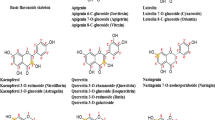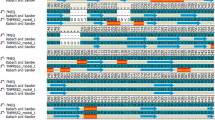Abstract
The binding of a natural anthocyanin to influenza neuraminidase has been studied employing mass spectrometry and molecular docking. Derived from a black elderberry extract, cyanidin-3-sambubiocide has been found to be a potent inhibitor of sialidase activity. This study reveals the molecular basis for its activity for the first time. The anthocyanin is shown by parallel experimental and computational approaches to bind in the so-called 430-cavity in the vicinity of neuraminidase residues 356–364 and 395–432. Since this antiviral compound binds remote from Asp 151 and Glu 119, two residues known to regulate neuraminidase resistance, it provides the potential for the development of a new class of antivirals against the influenza virus without this susceptibility.




Similar content being viewed by others
References
Layne SP, Monto AS, Taubenberger JK (2009) Pandemic influenza: an inconvenient mutation. Science 323:1560–1561
Durando P, Iudici R, Alicino C, Alberti M, de Florentis D, Ansaldi F, Icardi G (2011) Intradermal influenza vaccine and new devices: a promising chance for vaccine improvement. Human Vaccines 7:29–40
Pizzorno A, Bouhy X, Abed Y, Boivin G (2011) Generation and characterization of recombinant pandemic influenza A(H1N1)viruses resistant to neuraminidase inhibitors. J Infect Dis 203:25–31
Smith BJ, Colman PM, Von Itzstein M, Danylec B, Varghese JN (2001) Analysis of inhibitor binding in influenza virus neuraminidase. Protein Sci 10:689–696
von Itzstein M, Wu WY, Kok GB, Pegg MS, Dyason JC, Jin B, Van Phan T, Smythe ML, White HF, Oliver SW, Colman PM, Vargehese JN, Ryans DM, Woods JM, Bethell RC, Hotham VJ, Cameron JM, Penn CR (1993) Rational design of potent sialidase-based inhibitors of influenza virus replication. Nature 363:418–423
Lew W, Chen X, Kim CU (2000) Discovery and development of GS 4104 (oseltamivir) an orally active influenza neuraminidase inhibitor. Curr Med Chem 7:663–672
Air GM, Laver WG (1989) The neuraminidase of influenza virus. Proteins 6:341–356
Von Itzstein M, Thomson R (2009) Anti-influenza drugs: the development of sialidase inhibitors. Handb Exp Pharmacol 189:111–154
Monto AS, Fleming D, Henry D, De Groot R, Makela M, Klein T, Elliott M, Keene O, Man C (1999) Efficacy and safety of the neuraminidase inhibitor zanamivir in the treatment of influenza A and B virus infections. J Infect Dis 180:254–261
Treanor JJ, Hayden FG, Vrooman PS, Barbarash R, Bettis R, Riff D, Singh S, Kinnersley N, Ward P, Mills RG (2000) Efficacy and safety of the oral neuraminidase inhibitor oseltamivir in treating acute influenza: a randomized controlled trial. U.S. Oral Neuraminidase Study Group. J Am Med Assoc 283:1016–1024
Moss RB, Davey RT, Steigbigel RT, Fang F (2010) Targeting pandemic influenza: a primer on influenza antivirals and drug resistance. J Antimicrob Chemother 65:1086–1093
Yen HL, Herlocher LM, Hoffmann E, Matrosovich MN, Monto AS, Webster RG, Govorkova EA (2005) Neuraminidase inhibitor-resistant influenza viruses may differ substantially in fitness and transmissibility. Antimicrob Agents Chemother 49:4075–4084
Bloom JD, Gong LI, Baltimore D (2010) Permissive secondary mutations enable the evolution of influenza oseltamivir resistance. Science 328:1272–1275
Moscona A (2005) Oseltamivir resistance—disabling our influenza defenses. N Engl J Med 353:2633–2636
McKimm-Breschkin J, Trivedi T, Hampson A, Hay A, Klimov A, Tashiro M, Hayden F, Zambon M (2003) Neuraminidase sequence analysis and susceptibilities of influenza virus clinical isolates to zanamivir and oseltamivir. Antimicrob Agents Chemother 47:2264–2272
Hauge SH, Dudman S, Borgen K, Lackenby A, Hungnes O (2009) Oseltamivir-resistant influenza viruses A (H1N1), Norway, 2007–08. Emerg Infect Dis 15:155
Moscona A (2009) Global transmission of oseltamivir-resistant influenza. N Engl J Med 360:953–956
World Health Organization (2010) Oseltamivir resistance weekly update (August 2010)
van der Vries E, Stelma FF, Boucher CAB (2010) Emergence of multidrug-resistant pandemic influenza A (H1N1) virus. N Engl J Med 363:1381–1382
Birnkrant D, Cox E (2009) The emergency use authorization of peramivir for treatment of 2009 H1N1 influenza. N Engl J Med 361:2204–2207
Vavricka CJ, Li Q, Wu Y, Qi J, Wang M, Liu Y, Gao F, Liu J, Feng E, He J (2011) Structural and functional analysis of laninamivir and its octanoate prodrug reveals group specific mechanisms for influenza NA inhibition. PLoS Pathog 7:e1002249
Hurt AC, Holien JK, Parker MW, Barr IG (2009) Oseltamivir resistance and the H274Y neuraminidase mutation in seasonal, pandemic and highly pathogenic influenza viruses. Drugs 69:2523–2531
Lai JC, Garcia JM, Dyason JC, Bohm R, Madge PD, Rose FJ, Nicholls JM, Peiris JS, Haselhorst T, von Itzstein M (2012) A secondary sialic acid binding site on influenza virus neuraminidase: fact or fiction? Angew Chem Int Ed Engl 51:2221–2224
Dao TT, Nguyen PH, Lee HS, Kim E, Park J, Lim SI, Oh WK (2011) Chalcones as novel influenza A (H1N1) neuraminidase inhibitors from Glycyrrhiza inflata. Bioorg Med Chem Lett 21:294–298
Guo CT, Takahashi T, Bukawa W, Takahashi N, Yagi H, Kato K, Hidari KIPJ, Miyamoto D, Suzuki T, Suzuki Y (2006) Edible bird’s nest extract inhibits influenza virus infection. Antiviral Res 70:140–146
Kirchmair J, Rollinger JM, Liedl KR, Seidel N, Krumbholz A, Schmidtke M (2011) Novel neuraminidase inhibitors: identification, biological evaluation and investigations of the binding mode. Future 3:437–450
Liu AL, Liu B, Qin HL, Lee SM, Wang YT, Du GH (2008) Anti-influenza virus activities of flavonoids from the medicinal plant Elsholtzia rugulosa. Planta Med Natural Prod Med Plant Res 74:847–851
Liu AL, Wang HD, Lee SMY, Wang YT, Du GH (2008) Structure–activity relationship of flavonoids as influenza virus neuraminidase inhibitors and their in vitro anti-viral activities. Bio Med Chem 16:7141–7147
Miki K, Nagai T, Suzuki K, Tsujimura R, Koyama K, Kinoshita K, Furuhata K, Yamada H, Takahashi K (2007) Anti-influenza virus activity of biflavonoids. Bio Med Chem Lett 17:772–775
Zakay-Rones Z, Varsano N, Zlotnik M, Manor O, Regev L, Schlesinger M, Mumcuoglu M (1995) Inhibition of several strains of influenza virus in vitro and reduction of symptoms by an elderberry extract (Sambucas nigra L.) during an outbreak of influenza B Panama. J Altern Comp Med 1:361–369
Nagai T, Miyaichi Y, Tomimori T, Suzuki Y, Yamada H (1992) Anti-influenza virus activity of plant flavonoids having inhibitory activity against influenza virus sialidase. Antiviral Res 19:207–217
Nagai T, Miyaichi Y, Tomimori T, Suzuki Y, Yamada H (1990) Inhibition of influenza virus sialidase and anti-influenza virus activity by plant flavonoids. Chem Pharm Bull 38:1329–1332
Middleton E Jr, Kandaswami C (1992) Effects of flavonoids on immune and inflammatory cell functions. Biochem Pharmacol 43:1167–1179
Netzel M, Strass G, Herbst M, Dietrich H, Bitsch R, Bitsch I, Frank T (2005) The excretion and biological antioxidant activity of elderberry antioxidants in healthy humans. Food Res Intl 38:905–910
Lu SJ, Chong FC (2012) Combining molecular docking and molecular dynamics to predict the binding modes of flavonoid derivatives with the neuraminidase of the 2009 H1N1 influenza A virus. Int J Mol Sci 13:4496–4507
Zakay-Rones Z, Thom E, Wollan T, Wadstein JJ (2004) Randomized study of the efficacy and safety of oral elderberry extract in the treatment of influenza A and B virus infections. Int Med Res 32:132–140
Krawitz C, Mraheil MA, Stein M, Imirzalioglu C, Domann E, Pleschka S, Hain T (2011) Inhibitory activity of a standardized elderberry liquid extract against clinically-relevant human respiratory bacterial pathogens and influenza A and B viruses. BMC Comp Altern Med 11:16
Kiselar JG, Downard KM (1999) Direct identification of protein epitopes by mass spectrometry without immobilization of antibody and isolation of antibody–peptide complexes. Anal Chem 71:1792–1799
Kiselar JG, Downard KM (1999) Antigenic surveillance of the influenza virus by mass spectrometry. Biochemistry 38:14185–14191
Morrissey B, Downard KM (2006) A proteomics approach to survey the antigenicity of the influenza virus by mass spectrometry. Proteomics 6:2034–2041
Morrissey B, Streamer M, Downard KM (2007) Antigenic characterisation of H3N2 subtypes of the influenza virus by mass spectrometry. J Virol Methods 145:106–114
Schwahn AB, Downard KM (2009) Antigenicity of a type A influenza virus through comparison of hemagglutination inhibition and mass spectrometry immunoassays. J Immunoass Immunochem 30:245–261
Swaminathan K, Downard KM (2012) Anti-viral inhibitor binding to influenza neuraminidase by MALDI mass spectrometry. Anal Chem 84:3725–3730
Gattiker A, Bienvenut WV, Bairoch A, Gasteiger E (2002) FindPept, a tool to identify unmatched masses in peptide mass fingerprinting protein identification. Proteomics 2:1435–1444
Ho JWK, Morrissey B, Downard KM (2007) A computer algorithm for the identification of protein interactions from the spectra of masses (PRISM). J Am Soc Mass Spectrom 18:563–566
Li Q, Qi J, Zhang W, Vavricka CJ, Shi Y, Wei J, Feng E, Shen J, Chen J, Liu D, He J, Yan J, Liu H, Jiang H, Teng M, Li X, Gao GF (2010) The 2009 pandemic H1N1 neuraminidase N1 lacks the 150-cavity in its active site. Nat Struct Mol Biol 17:1266–1268
Morris GM, Huey R, Lindstrom W, Sanner MF, Belew RK, Goodsell DS, Olson AJ (2009) AutoDock4 and AutoDockTools4: automated docking with selective receptor flexibility. J Comput Chem 30:2785–2791
Hartshorn MJ (2002) AstexViewer: a visualisation aid for structure-based drug design. J Comput Aided Mol Des 16:871–881
Chong AKJ, Pegg MS, von Itzstein M (1991) Influenza virus sialidase: effect of calcium on steady-state kinetic parameters. Biochim Biophys Acta 1077:65–71
Potier M, Mameli L, Bélisle M, Dallaire L, Melançon SB (1979) Fluorometric assay of neuraminidase with a sodium (4-methylumbelliferyl-alpha-D-N-acetylneuraminate) substrate. Anal Biochem 94:287–296
Ferraris O, Kessler N, Lina B (2005) Sensitivity of influenza viruses to zanamivir and oseltamivir: a study performed on viruses circulating in France prior to the introduction of neuraminidase inhibitors in clinical practice. Antiviral Res 68:43–48
Acknowledgments
This work was supported by an Australian Research Council Discovery Project Grant (DP110101702) awarded to Kevin Downard that also provides scholarship support for Kavya Swaminathan. Kevin Downard thanks Mark von Itzstein for allowing him to spend a period of his sabbatical at the Institute for Glycomics at Griffith University to initiate this project.
Author information
Authors and Affiliations
Corresponding author
Rights and permissions
About this article
Cite this article
Swaminathan, K., Dyason, J.C., Maggioni, A. et al. Binding of a natural anthocyanin inhibitor to influenza neuraminidase by mass spectrometry. Anal Bioanal Chem 405, 6563–6572 (2013). https://doi.org/10.1007/s00216-013-7068-x
Received:
Revised:
Accepted:
Published:
Issue Date:
DOI: https://doi.org/10.1007/s00216-013-7068-x




